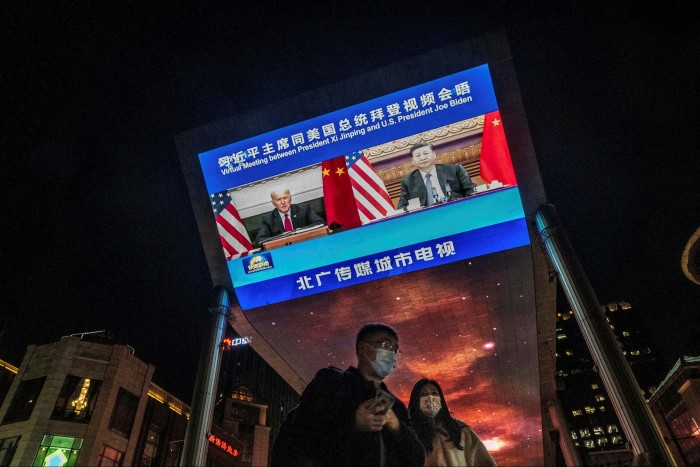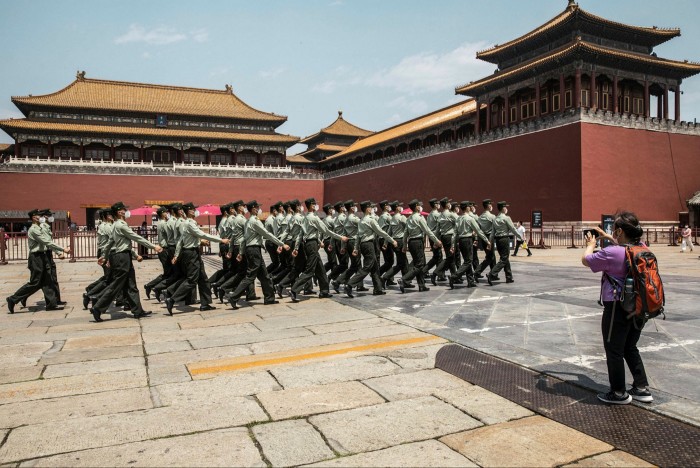China’s high-tech rise sharpens rivalry with the US

Simply sign up to the Chinese politics & policy myFT Digest -- delivered directly to your inbox.
As the harbingers of China’s rise to superpower status proliferate, the urge in Washington to decouple from its “strategic competitor” intensifies. But, in 2022, the increasingly bipolar world that results from this basic dynamic is set to cause a host of geopolitical headaches for smaller powers and multinational corporations.
The second half of 2021 was marked by revelations of a sharp upturn in China’s strategic strength. Beijing stunned the Pentagon and the US intelligence community in July by firing a hypersonic weapon, in a test that suggested the Chinese military could hit targets anywhere in the US with nuclear weapons.
General Mark Milley, chair of the US joint chiefs of staff, reacted by saying the event was close to a “Sputnik moment” — in reference to the launch of an artificial satellite by the Soviet Union in 1957, which demonstrated Moscow’s growing prowess and intensified Cold War competition.
Milley’s comment forms part of a pattern. In an article in early December, Graham Allison of Harvard University and Eric Schmidt, the former chief executive of Google, argued that “China will soon lead the US in tech”.
However, as China’s tech knowhow grows, the pushback from Washington strengthens. In one recent example, the US last month put China’s Academy of Military Medical Sciences and 11 affiliated biotechnology research institutes on an export blacklist, for allegedly helping the Chinese military to develop “brain-control” weapons.
Exactly what such weapons entail remains hazy, but a senior US official said China was using emerging biotechnologies to develop future military applications — including “gene editing, human performance enhancement [and] brain-machine interfaces”. The head of the US National Counter-intelligence and Security Center, Michael Orlando, identified biotechnology as one of five key sectors in which Chinese actors are trying to obtain US technologies.

These developments, taken together, show the depth of a US-China rivalry that looks set to characterise 2022. Not only is China’s ascent towards the commanding heights of technology obvious in several sectors, but the dividing line between civilian and military uses of technology is also becoming thinner.
Xi Jinping, China’s leader, has no illusions. “Technological innovation has become the main battleground of the global playing field, and competition for tech dominance will grow unprecedentedly fierce,” he said last year.
As a result, momentum toward “decoupling” is intensifying in both countries. US investors are banned from investing in some five dozen Chinese groups that have been placed on a Treasury blacklist. Washington accuses them of involvement in a Chinese military-industrial complex perpetrating human rights abuses against Uyghurs and other ethnic minorities in the northwestern region of Xinjiang.
Beijing, for its part, has said domestic companies must gain approval before listing overseas if they operate in sectors deemed off-limits to foreign investors. The move looks set to cast a pall over listings on US markets by Chinese corporations, jeopardising a fundraising avenue that had allowed 248 Chinese companies worth a total of $2.1tn in May last year to list on US exchanges.
All of these stresses play into, and derive impetus from, the biggest strategic bugbear between the two superpowers: Taiwan. The island 161km from China’s south-east coast is ground zero for superpower rancour. China claims Taiwan as part of its territory and threatens to attack if Taipei declares independence. For the US, Taiwan is a crucial ally in Asia — even though Washington and Taipei do not have formal diplomatic relations.


In December last year, Antony Blinken, US secretary of state, warned of “terrible consequences” in the event of a Chinese invasion. “We’re committed to helping Taiwan develop and maintain the capability to defend itself,” he said, adding that nobody wanted to see a conflict develop.
Away from geopolitics, China’s role in the world is shifting in other important ways. For several years, China has contributed more to global GDP growth than any other country and, before the coronavirus pandemic struck, often accounted for close to one-third of the world’s growth.
But, in 2021, China contributed only about one-quarter of global GDP growth as its property sector lost momentum, birth rates declined and debt levels rose. These headwinds are unlikely to dissipate any time soon. What is in prospect now is a shift in the nature of China’s growth model: less dependence on property and infrastructure investment and greater reliance on high-tech manufacturing and consumer spending to drive wealth creation.
In this regard, two big policy mantras have been put forward by Beijing: common prosperity and dual circulation. Each is likely to be further emphasised this year and in several years to come.
Common prosperity signifies an intent to raise the living standards of some 600m Chinese “have-nots”. Dual circulation entails a shift toward greater self-reliance, primarily by localising China’s supply chain.
China’s place in the world is changing. From an international perspective, its growing power looks likely to stoke further rivalry with the US and other western powers. Meanwhile, at home, a maturing growth profile, coupled with a strong incentive to localise, may make the fabled Chinese market an increasingly tricky one for multinationals to navigate.
Comments